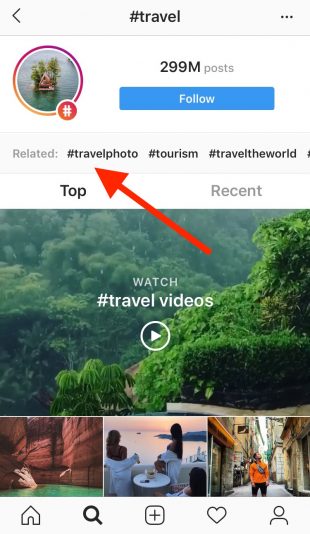Keep exploring the most effective way to use Instagram hashtags and get results.
The way to find the best Instagram hashtags for your brand
The hashtags you need to use will depend on what area your business operates in.
For example, you’re a social media manager working for a travel agency. There are a ton of hashtags that are popular with jet-setters: #welltravelled, #justbackfrom, #whatsinmybag, and #passportexpress—to name a couple of. Tag your posts with any number of these and you’ll probably get a few extra likes.
However, in case you need to increase engagement and gain quality followers, include more specific hashtags. In case you post a photo of a travel destination, tag it with related location hashtags and the resort’s branded hashtag (if there is one).
How do you find out which hashtags your viewers are already following? Here are a few ideas that will help you answer that question.
What hashtags are used by your competitors?
You might find new hashtags to add to your repertoire. Or you may decide you don’t want to compete for the same eyeballs, in which case you may seek for different hashtags to use.
Use hashtags that influential individuals in your industry are using
These people are already well-established with your viewers, so why not learn from the best?
Get a social media listening tool
Use Instagram’s search function
Type a keyword that’s related to your brand into Instagram’s search bar (a.k.a the Explore function) then choose the Tags tab. Instagram will provide you with a list of all the hashtags with that keyword, as well as numerous posts that are tagged with it.
A large number might mean a lot of people following that hashtag, however, it also means there’s a ton of content on it and your posts may get lost. Experiment with a mixture of popular and niche hashtags to seek out your brand’s sweet spot.
Think about related hashtags
On any hashtag page, right above the “Top” and “Recent” tabs, you’ll discover a list of related hashtags that you can scroll through by swiping left. This is a great way to discover relevant hashtags that could be a bit more niche. And that means even more targeted viewers with less content to compete with.
Look to your most successful posts for trends
Take a look at posts containing a hashtag you’re already having success with. Do you see a trend of different common hashtags that could be included in future posts?
In terms of selecting Instagram hashtags, the golden rule is: use only hashtags that are related to your brand, industry, and viewers.
#Love is one of the most popular hashtags on Instagram, tagged in over 1.3 billion posts. However, your company is not going to attract these hashtag followers in case you attach it to a photo of your boring boardroom.
Again, if you tag your photos with popular, however unrelated hashtags, you could be flagged as a spammer.
11 Instagram hashtag tips and tricks
Let’s overview what we’ve learned so far, plus a couple of more strategies that will help you achieve your Instagram goals.
1. Don’t use irrelevant hashtags
Stuffing irrelevant hashtags onto posts is spammy behavior. It will annoy individuals who follow these hashtags and they will likely tell Instagram to “Don’t Show for This Hashtag.”
Hashtags must be used strategically. You will only increase engagement in case you give the viewers what they’re searching for, i.e., quality content that speaks to their interests.
2. Use the right amount of hashtags
According to an analysis by TrackMaven, posts with nine hashtags receive the most engagement.
However, that doesn’t mean you need to tag every post with lots of hashtags. One more time, the hashtags you use have to be related to the content. Using a popular hashtag like #followmeback might get you a few new followers, however, they’ll likely be the wrong kind—spammers or individuals looking to inflate their follower count. These individuals will not engage with your brand.
The content of your posts must inform what and how many hashtags are used.
3. Use specific or niche hashtags
The more specific the hashtag, the more targeted your viewers will be. And a targeted viewer means a higher chance of quality engagement.
In case you’re after Volkswagen lovers, for instance, the hashtag #vwvan will get you in front of a higher converting audience than something broader like #van. (However, ensure your image is actually of a Volkswagen van.)
4. Don’t swear off popular hashtags entirely
As long as they’re related to the post and used sparingly, popular hashtags may help increase your reach without making you seem desperate or spammy.
5. Make sure that hashtag means what you think it means
You don’t need to inadvertently attach your brand to a raunchy or nefarious campaign. Once you combine two or three words, does it spell out something else?
There’s a pretty famous instance of this from 2012. Susan Boyle had a new album out, and the hashtag to promote it used the phrase “Susan album party.” And without spaces, some individuals thought “Su’s” party was of a very different sort.
Before using any hashtag, make sure to browse through the hashtag page to ensure the associated content is appropriate.



